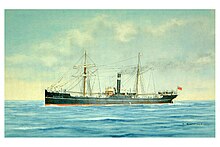Camorta (ship)
|
||||||||||||||||||||
|
||||||||||||||||||||
|
||||||||||||||||||||
|
||||||||||||||||||||
The Camorta was a passenger ship of the British shipping company British India Steam Navigation Company put into service in 1881 , which transported passengers , mail and cargo between different ports in British India . On May 6, 1902, the ship got into a cyclone in the Baragua Flats near the mouth of the Irrawaddy River and sank. All 739 people on board were killed.
history
The 2,119-ton steamer Kamorta originated in 1880 in the Dock Point House Shipyard shipyard A. & J. Inglis at the River Clyde in Glasgow and ran on 16 November 1880 from the stack . It was completed on January 25, 1881. It was powered by compound steam engines. The hull was made of iron .
It was initially owned by A. Gray & ES Dawes of Glasgow, but after completion it was bought by the British India Steam Navigation Company (BISN). This was a British shipping company founded in 1856 under the name Calcutta and Burmah Steam Navigation Company (C & BSN), which had specialized in the mail and passenger traffic from Calcutta in western Bengal to Yangon in Myanmar . The ship was named after an island in the Nicobar Islands in the Indian Ocean .
In April 1902 the Camorta ran out in Madras on the Indian west coast for another crossing through the Bay of Bengal with the destination Rangoon. There were 89 crew members and 650 passengers on board. Except for nine men of the crew, all persons on board were Indian. The ship was supposed to reach Rangoon on May 5th. On May 6, the Camorta , which was already running late, had reached the mouth of the Irrawaddy River in the Andaman Sea when it got caught in a cyclone in the Baragua Flats and sank in it. None of the 739 people on board survived the disaster .
The Camorta was reported missing on May 13th. Shortly afterwards, two empty lifeboats of the ship were discovered in the Bay of Bengal . The wreck itself was found on June 4th in 27 m deep water. The masts still protruded about 2 m from the water. With no surviving eyewitnesses to the disaster, the exact circumstances of the doom could never be clarified. Because the Camorta was a ship registered in Great Britain and operated by a British shipping company, her sinking represents one of the greatest loss of life on a British passenger ship after the Titanic (1912) and the Lusitania (1915).
See also
Web links
- Information about the ship
- Entry in the Miramar Ship Index
- Key data in the Clydebuilt Ships Database
- The Camorta Probably Lost . (PDF) In: New York Times , May 15, 1902; Report on the disappearance of the ship

